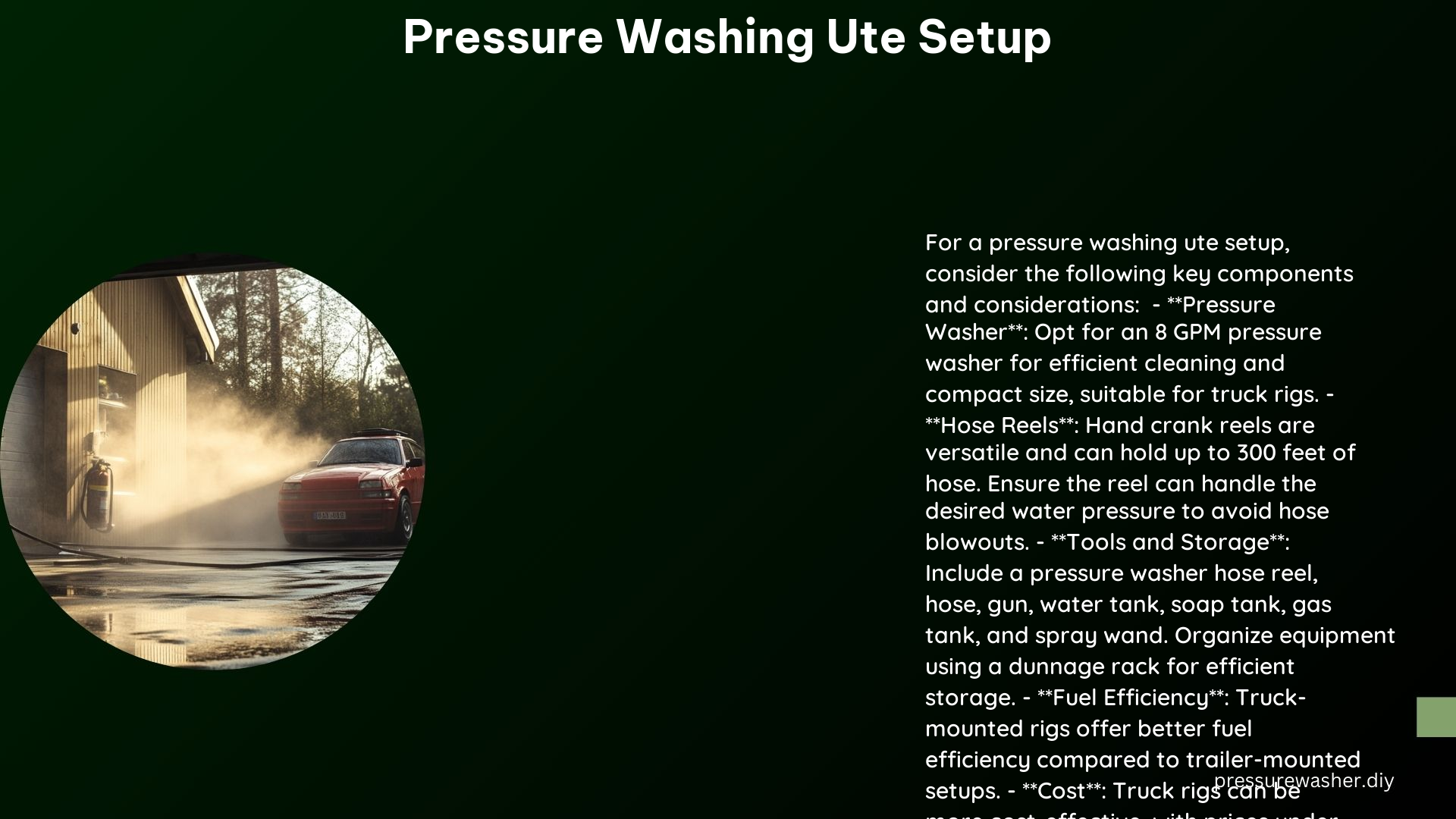Pressure washing setups for utes (utility vehicles) are designed to provide a versatile and efficient way to clean surfaces. This comprehensive guide covers the key components, technical specifications, setup and installation, and DIY tips for creating a top-notch pressure washing ute that can handle a wide range of cleaning tasks with ease.
Key Components
Pressure Washer
The heart of the pressure washing ute setup is the pressure washer. These powerful machines are rated by their PSI (pounds per square inch) and GPM (gallons per minute) flow rate, which determine the cleaning power and efficiency. For a pressure washing ute, a gas-powered pressure washer with a flow rate of 8-10 GPM and a PSI of 3,000-4,000 is recommended for cleaning large surfaces like houses, buildings, and heavy equipment.
Hose Reels
Hose reels are essential for managing the high-pressure hoses used in the pressure washing setup. Hand-crank hose reels are a popular choice for utes, as they allow for easy deployment and retraction of up to 300 feet of hose. These reels can be mounted on the side of the ute bed for convenient access.
Hoses
The high-pressure hoses used in a pressure washing ute setup are designed to withstand the intense water pressure and deliver the cleaning solution to the spray wand. The length and type of hose will depend on the specific needs of the job, but a standard setup may include a 50-foot high-pressure hose and a 25-foot garden hose for water supply.
Spray Wand
The spray wand is the tool used to apply the high-pressure water stream to the surface being cleaned. It typically features adjustable nozzles that allow for a variety of spray patterns, from a focused jet to a wide fan, to tackle different cleaning tasks.
Water Tank
A water tank is a necessary component of a pressure washing ute setup, as it provides the water supply for the pressure washer. The size of the tank will depend on the volume of water needed for the job, but a 100-gallon tank is a common choice for residential and light commercial cleaning tasks.
Soap Tank
In addition to the water tank, a soap tank is used to store and dispense cleaning solutions. This allows the operator to apply soap directly through the pressure washer, enhancing the cleaning power and efficiency.
Gas Tank
If the pressure washer is gas-powered, a gas tank is required to fuel the engine. The size of the gas tank will depend on the fuel consumption of the specific pressure washer model and the duration of the cleaning tasks.
Garden Hose Reel
A garden hose reel is used to store and manage the water supply hose that connects the pressure washer to the water source, such as a faucet or water spigot. This helps keep the hose organized and prevents tangles or kinks.
Soft Wash System
For more delicate cleaning tasks, a soft wash system can be added to the pressure washing ute setup. This includes a soap fogger and other specialized equipment for applying low-pressure, high-volume cleaning solutions to surfaces like siding, roofs, and vehicles.
Technical Specifications

Here are the typical technical specifications for a well-equipped pressure washing ute setup:
| Component | Specification |
|---|---|
| Pressure Washer | 8-10 GPM, 3,000-4,000 PSI, gas-powered |
| Hose Reels | Hand-crank, up to 300 feet of hose capacity |
| Hoses | 50-foot high-pressure hose, 25-foot garden hose |
| Water Tank | 100-gallon capacity |
| Soap Tank | 5-10 gallon capacity |
| Gas Tank | Sized to match pressure washer fuel consumption |
Setup and Installation
Mounting
Securely mount the pressure washer, hose reels, and other components to the ute bed using heavy-duty brackets, clamps, or other fasteners. This ensures the equipment remains stable and secure during transport and operation.
Organization
Carefully plan the layout of the components to optimize accessibility and ease of use. Group related items together, such as the pressure washer, hose reels, and spray wand, to streamline the workflow.
Protection
Protect the pressure washing equipment from the elements and potential damage by using weatherproof covers or enclosures. This helps extend the lifespan of the components and ensures reliable performance in various weather conditions.
DIY Tips
Plan Ahead
Thoroughly plan the pressure washing ute setup before beginning the installation. Measure the ute bed dimensions, consider the placement of each component, and create a detailed layout to ensure everything fits and functions as intended.
Measure Carefully
Accurate measurements are crucial for a successful pressure washing ute setup. Double-check the dimensions of the ute bed, the components, and the clearances needed for proper installation and operation.
Secure Components
Securely fasten all the pressure washing equipment to the ute bed using high-quality hardware and fasteners. This prevents the components from shifting or becoming dislodged during transport or use.
References
- Pressure Washing setup for BEGINNERS (Truck bed) – YouTube video
- Truck Bed Setup – Reddit thread
- The Ultimate Guide to Pressure Washer Truck Rig Setups – Blog post
